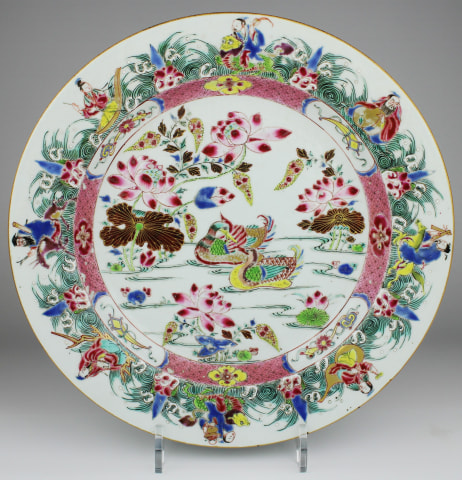BH55 BH56
Literature
Mandarin ducks are referred to in Chinese as yuanyang, where yuan and yang respectively stand for male and female mandarin ducks. In traditional Chinese culture, mandarin ducks are believed to be lifelong couples, unlike other species of ducks. Hence they are regarded as a symbol of conjugal affection and fidelity, and are frequently featured in Chinese art.
A pair of mandarin ducks and lotus is especially auspicious. A word for lotus in Chinese, he, is a homophone for the word for harmony, while another word for lotus, lian, is homophonous to a word meaning successive. So the lotus combined with a pair of mandarin ducks, which symbolises fidelity, form an appropriate wedding motif wishing the couple a harmonious marriage blessed by the birth of many illustrious sons.
The Immortals
Zhang Guolao (7th/8th century CE) was a recluse who had supernatural powers of magic such as rendering himself invisible. He is usually depicted with a white mule which he rode backwards over great distances, and, when not required was folded away and put in his wallet. When he wished to resume his travels, he squirted some water on the wallet and the mule at once appeared. His emblem is a You Gu, a kind of musical instrument in the shape of a bamboo tube or drum with two rods to beat it.
Li Tieguai is represented as a beggar leaning on an iron staff with a pilgrim's gourd. Due to his magic powers he spent much time in spirit in the celestial regions, leaving his body, apparently dead, in charge of his disciple. Once when he was absent longer than usual, having to go and take care of his sick mother, his servant decided that his master was really dead this time and buried the body. When the soul of Li Tieguai returned, he found that he had no body into which to enter, so he entered the body of the first good person he could find, a lame beggar. His emblem is a gourd which is said to contain all kinds of magical cures.]
Zhongli Quan, Zhou dynasty, 1122 249 B.C., chief of the Eight Immortals, who had the secret of the elixir of life and powers of transmutation, is depicted as a fat man sometimes holding a peach in his hand and always grasping his emblem, a fan, which is said to be capable of resuscitating the souls of the dead.
Li Dongbin, circa 750 A.D., a scholar or recluse, he learned the secrets of Daoism from Zhongli Quan. He is the patron saint of the barbers and is also worshipped by the sick and is able to rid the world of evils. His emblem is a sword which is used for dispelling evil spirits.
Cao Guo Qiu, 930 999 A.D., son of a military commander and brother of the Empress Cao of the Song Dynasty. He is patron saint of the theatrical profession. His emblem, the castanets, which symbolise revival, are said to be derived from the court tablet, authorising free access to the palace, to which he is entitled owing to his birth.
Han Xiangzi is credited with the power of making flowers grow and blossom instantaneously. His emblem is the flute and he is the patron saint of musicians. He wandered the country charming the birds and the beasts with his music. He had no idea of the value of money, and when given any he used to scatter it on the ground.
Lan Caihe, 700 - 800 A.D. Variously stated to have been a woman and a hermaphrodite. She is represented as dressed in a long gown, she wandered the country waving a wand and denouncing this fleeting life and its delusive pleasures. Her emblem is the flower‑basket which she carries, and she is the patron saint of the florists.
He Xiangu was the daughter of a 7th century A.D. shopkeeper of Lingling, Hunan. Having eaten the supernatural peach , she became a fairy. She wandered alone in the hills and lived on a diet of crushed mother of pearl and moonbeams. Her emblem is the lotus and she is sometimes portrayed as standing on a lotus petal holding a fly whisk in her hand.
A similar charger is illustrated by Thomas V. Litzenburg Jr. in Chinese Export Porcelain in the Reeves Center Collection at Washington and Lee University (2003, p. 65, no. 42).




